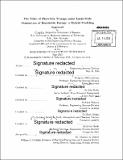| dc.contributor.advisor | Ignacio Perez-Arriaga and John Reilly. | en_US |
| dc.contributor.author | Octaviano Villasana, Claudia Alejandra | en_US |
| dc.contributor.other | Massachusetts Institute of Technology. Engineering Systems Division. | en_US |
| dc.coverage.spatial | n-us--- n-mx--- | en_US |
| dc.date.accessioned | 2015-11-09T19:51:14Z | |
| dc.date.available | 2015-11-09T19:51:14Z | |
| dc.date.copyright | 2015 | en_US |
| dc.date.issued | 2015 | en_US |
| dc.identifier.uri | http://hdl.handle.net/1721.1/99824 | |
| dc.description | Thesis: Ph. D., Massachusetts Institute of Technology, Engineering Systems Division, 2015. | en_US |
| dc.description | Cataloged from PDF version of thesis. | en_US |
| dc.description | Includes bibliographical references (pages 219-234). | en_US |
| dc.description.abstract | Due to the physics of electricity, and the current high costs of storage technologies, electricity generation and demand need to be instantaneously balanced at all times. The large-scale deployment of intermittent renewables requires increased operational flexibility to accommodate fluctuating and unpredictable power supply while maintaining this balance. This dissertation investigates the value of electricity storage for the economy. Specifically, what is the value of storage under large-scale penetration of renewable energy in the context of climate policy? To answer this question, I develop a new hybrid modeling approach that couples an electricity sector model to the MIT EPPA model, a general equilibrium model for climate change policy analysis. The electricity sector model includes the main constraints for reliable and secure operation; electricity demand; wind, solar and hydro resources on the hourly time-scale; and utility-scale storage technologies. The hybrid modeling approach reconciles the very short-term dynamics required for renewables and storage technologies assessment, and the long-term time-scale required for the analysis of economic and environmental outcomes under climate policy. Using Mexico as a case study, this dissertation analyses policies currently under discussion in the country. The experimental design explores increasing shares of renewables with varying levels of storage capacity. Under scenarios with increasing shares of renewables in the power grid, the value of storage increases sharply. By 2050, with 50% renewables penetration, the present value of storage capacity per MW installed in Mexico is estimated at $1500/MW and $200/MWh. Energy management services resulted in the highest value component (58%), followed by operational reserves provision (22%) and capacity payments (18%). Storage capacity in the system changes both investments and operational decisions, allowing larger penetration of wind technologies and displacing gas technologies. Storage capacity in the system reduces price volatility and the occurrence of negative prices that would otherwise result as renewables scale up. The general equilibrium analysis shows that the availability of competitive storage technologies under an economy-wide climate policy reduces the overall policy costs. Simulating a 50% emissions reduction by 2050, the model demonstrated that storage could decrease total welfare losses by 0.7% when compared to the case without storage. Despite the sharp increase in the value of storage driven by renewables penetration, the findings suggest that the current cost of most storage technologies will still have to drastically be reduced for them to be economical. | en_US |
| dc.description.statementofresponsibility | by Claudia Alejandra Octaviano Villasana. | en_US |
| dc.format.extent | 234 pages | en_US |
| dc.language.iso | eng | en_US |
| dc.publisher | Massachusetts Institute of Technology | en_US |
| dc.rights | M.I.T. theses are protected by copyright. They may be viewed from this source for any purpose, but reproduction or distribution in any format is prohibited without written permission. See provided URL for inquiries about permission. | en_US |
| dc.rights.uri | http://dspace.mit.edu/handle/1721.1/7582 | en_US |
| dc.subject | Engineering Systems Division. | en_US |
| dc.title | The value of electricity storage under large-scale penetration of renewable energy : a hybrid modeling approach | en_US |
| dc.type | Thesis | en_US |
| dc.description.degree | Ph. D. | en_US |
| dc.contributor.department | Massachusetts Institute of Technology. Engineering Systems Division | |
| dc.identifier.oclc | 927322908 | en_US |
